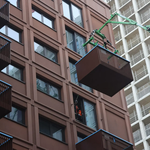^GO was unusually fortunate that the railways had corridors in the GTA that they no longer needed and were willing to sell. And even more fortunate that Toronto’s original rail system was built with spokes radiating from the city centre in so many directions. If one compares to say Ottawa, or Montreal, their original as-built rail network is not aligned to current development and movement needs and so the regional rail network is not as robust and transit routes have had to be carved out elsewhere..
It’s high time that Canada began planning passenger rail corridors at the federal and provincial level, even if the need or affordability for such corridors hasn’t arrived. Those corridors should inform municipal level zoning and development plans.
If you look at the planning that goes into the 400 series highways, the layout of routes and the acquisition of land is a multiple-decade process. Pickering Airport was planned 50 years ago, and remains a possibility if the economics eventually justify it. With rail, the best we seem to do is trail-bank old abandoned rail lines, but again there may not be a rail line where we will need it, and the lines that are being abandoned are not where we intend to build.
Getting back to Toronto, the planning for today’s GO network happened in the late 1950’s…. the public debate over the construction of CN’s bypass acknowledged that CN would no longer need all its central infrastructure, and the notion of a regional passenger network was explicitly discussed. That’s a remarkably foresighted bit of history…. sometimes we lose sight of how good that original vision and decisionmaking was, because people thought along a 50-75 year timeline instead of ten years.
So, yes, we need to plan for new rail corridors in lots of places…. we just don’t need to build them all yet.
The HFR proposal has made a huge impact, IMHO, because it has moved government and political thinking from debating whether we need better rail infrastructure to what kind we need and when do we need it. That’s a huge reversal from the Jack Pickersgill mentality when VIA was born. We may not be ready to commit yet, and personally while I’m not a HSR advocate I do hope that we will continue to look for better places to build a new line than through Sharbot Lake. But we definitely need to stop looking at existing lines on the map and dreaming about how we can cram a passenger network onto somebody else’s freight infrastructure when the two need to each operate efficiently without getting in each others’ way..
- Paul




